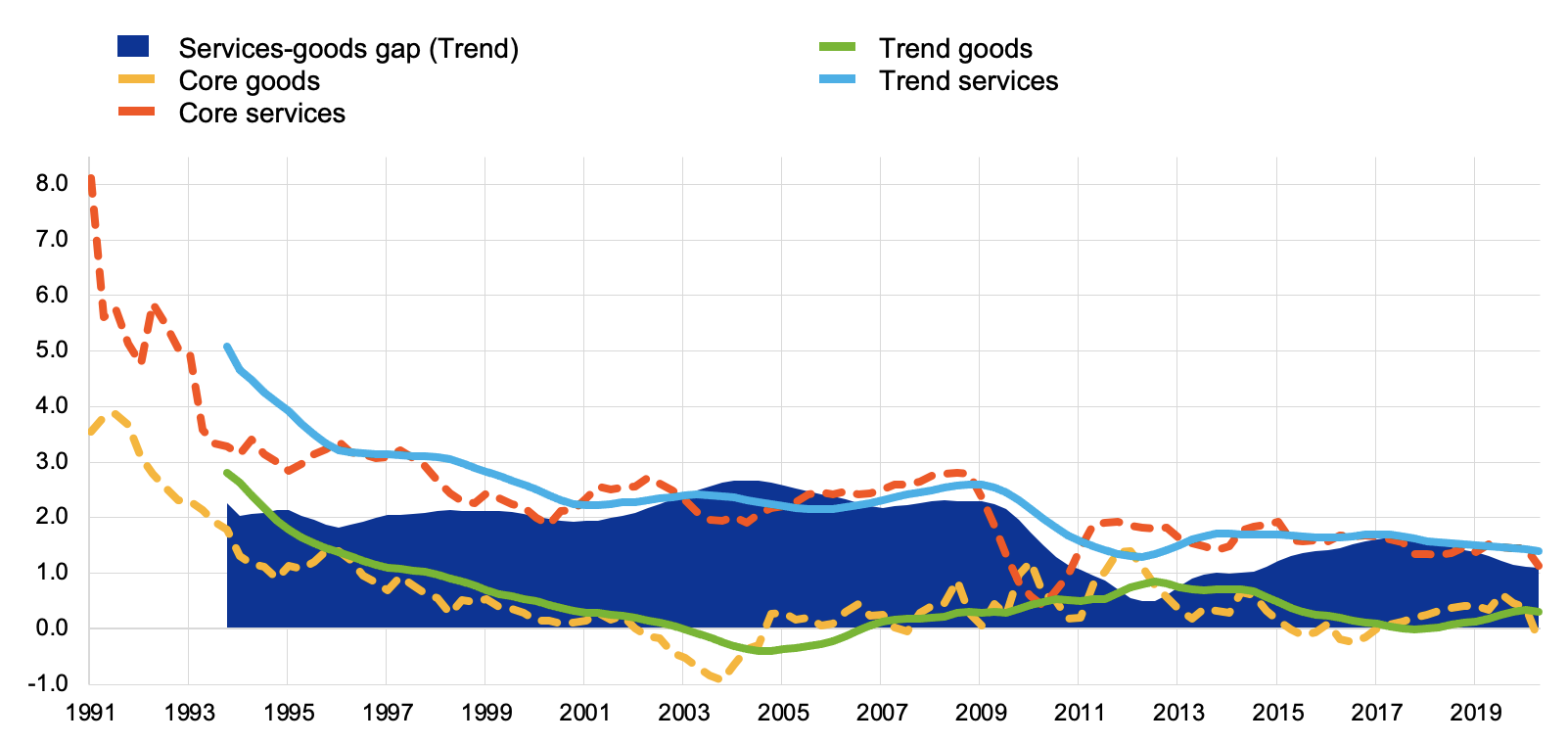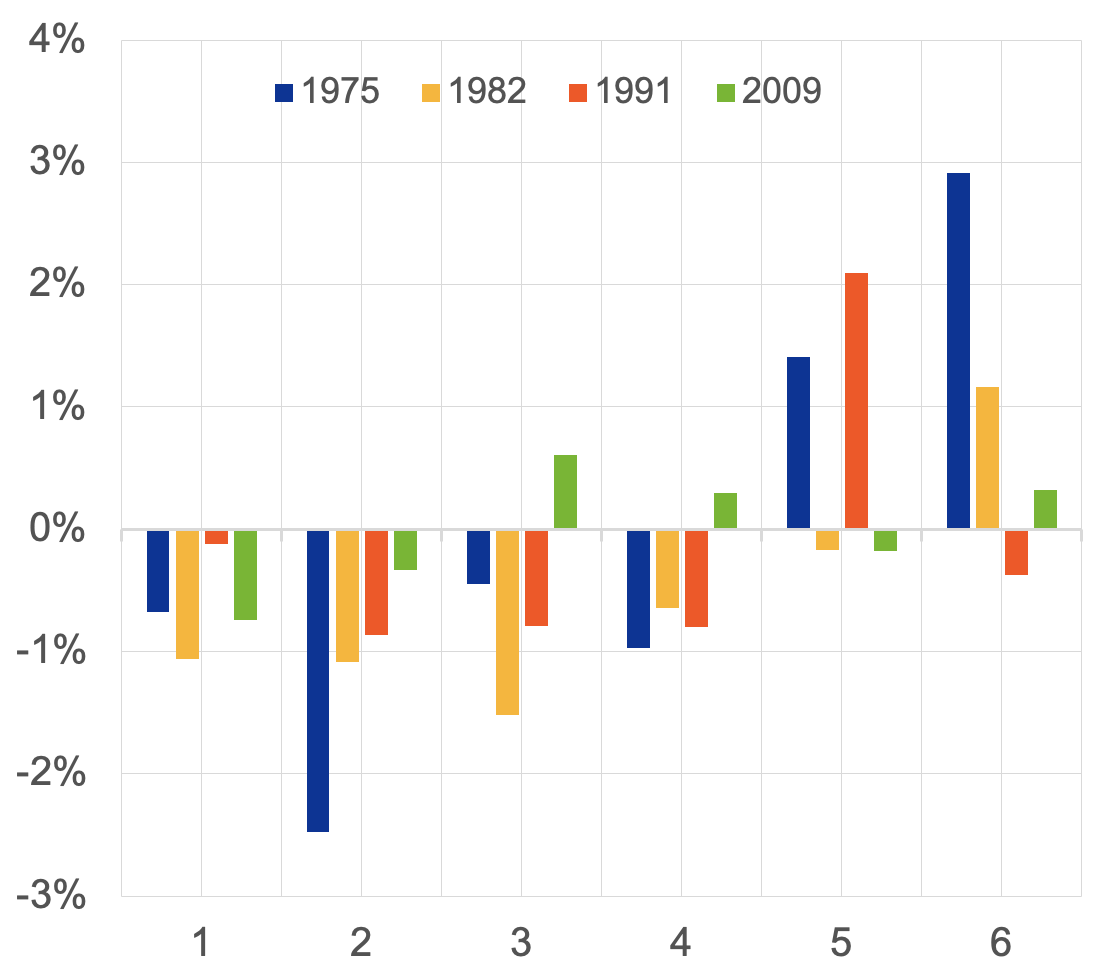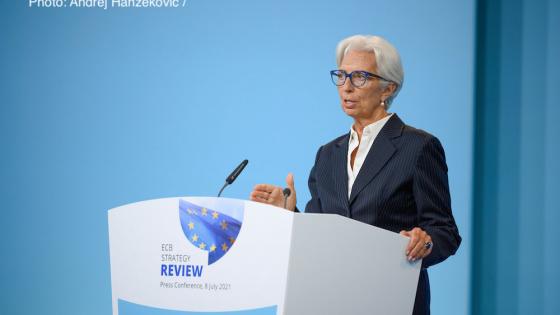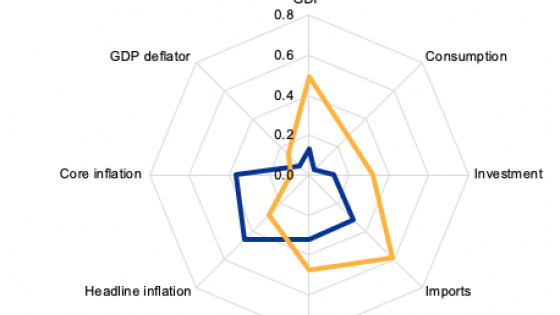After being dormant for about two decades, inflation has started making headlines again. For example, the OECD forecasts US inflation to reach 3.6% in 2021, a remarkable rise from the 1.8% averaged over the last decade. Supply bottlenecks, the shortage of semiconductors, rising commodity prices, and adjustment in Covid-19 sensitive sectors are pushing consumer prices up. The debate on whether these are temporary factors, or whether they could lead to more entrenched price pressure, is intertwined with a longer-term discussion on the post-pandemic economic landscape and to the role that globalisation could have on price dynamics (e.g. Blanchard 2020). To what extent was globalisation responsible for low inflation before the pandemic? Will inflation be steadily higher going forward? These questions have been at the centre of much recent research of the ECB strategy review (Angeloni and Gros 2021, Reichlin et al. 2021), which devoted part of its analysis to the relationship between globalisation and inflation (ECB 2021). This column summarises the main findings.
Globalisation coincided with rising synchronisation of inflation across countries
Globalisation is defined as the process of growing interdependence among the world’s economies, in terms of cross-border flows of trade, finance, and information. After increasing rapidly in the 1990s (a phase known as hyper-globalisation), global economic integration (both real and financial) has slowed its pace since the Global Crisis, in the context of lower economic growth and amidst rising protectionism. Together with automation and digitalisation, globalisation has reshaped international economic relationships and has often been cited as one of the most plausible explanations for pervasive structural changes in the economy, such as persistently low inflation and interest rates, and declining productivity growth.
In the period of rising globalisation, the synchronisation of inflation rates among advanced economies has risen substantially (Auer et al. 2017). Carriero et al. (2019), among others, show that common factors explain a large part of inflation dynamics in the euro area and other advanced economies. Increased cross-country correlation is mostly due to large swings in commodity prices, which affect inflation through energy and food prices. To the extent that these patterns reflect the increased weight of emerging markets in the global economy, they can be indirectly traced back to globalisation (Forbes 2019b). Evidence of synchronisation, however, is much weaker for core inflation rates, suggesting that underlying inflation trends have not been affected as much by rising international integration.
Globalisation has had a negative but limited effect on trend inflation
Globalisation affects consumer prices through various channels (e.g. cheaper imports, increased labour supply, increased competition, and integration of global supply chains). A protracted process of globalisation can have a one-off effect on the price level, but also exert downward pressure on expectations and inflation (Auer and Fischer 2010). On the other hand, globalisation also favours the emergence of superstar firms that operate in oligopolistic contexts and tend to absorb cost fluctuations in their margins. In this way, it can paradoxically reduce rather than increase competition (Diez et al. 2021). The review analysed to what extent globalisation has contributed to the decline in trend inflation in advanced economies over the past 30 years. The analysis concluded that while global integration appeared to have exerted downward pressures on inflation, it does not appear to be the main factor behind the low inflation phenomenon.
The level of inflation in advanced economies has collapsed since the early 1990s, both in the goods and services sectors, and then stabilised towards the end of that decade (Figure 1). Globalisation, however, has shown a strong acceleration between the end of the 1990s and the run up of the Global Crisis. During that period of hyper-globalisation trade flows grew faster than global GDP and the structure of trade was profoundly modified by the surge in the role of emerging economies (mostly Asian) in world trade and by the intensification of global value chains (Baldwin 2019). Since the Global Crisis, trade slowed to grow at around the same speed as global production.
Figure 1 Trend inflation in goods and services in advanced economies
(Percent and percentage points)
Sources: ECB calculations and national sources.
Notes: Inflation trends are computed based on 12-quarters moving averages of core inflation in advanced economies, computed as weighted average (GDP PPP weights) of six advanced economies (Australia, Canada, euro area, Japan, UK, and US). Latest observation: 2020 Q2.
Thus, a first inspection of the data shows that the collapse in inflation in advanced economies precedes the peak of globalisation. Also, goods and services follow parallel trends albeit the former sector is arguably more exposed to trade and globalisation forces. Quantitative analyses (Attinasi and Balatti 2021) confirm this intuition and are in line with the results in Forbes (2019b), who concludes that “global variables [...] have limited ability to improve our understanding of the dynamics of the underlying, slow-moving trend in inflation, and they do not appear to have become more important over the last decade.” In the same spirit, Nickel (2017) also finds that measure of global slack add little information to domestic slack when modelling euro area inflation. Similarly, although the share of goods originating from low-wage countries in euro area consumer expenditures doubled since the beginning of the 2000s, the report found that their overall contribution to consumer price index (CPI) inflation was rather modest.1
Globalisation contributed mildly to the flattening of the Phillips curve
Inflation has also become less sensitive to the economic cycle. For example, the Global Crisis induced much less marked inflation movements than previous global recessions (Figure 2).
Figure 2 Changes in core inflation following recessions
(y-axis: percentage points; x-axis: years after global recession)
Sources: World Bank, OECD MEI, ECB calculations.
Notes: Global core inflation estimated as a GDP-weighted average of 14 major economies (China, US, UK, India, Japan, Russia, Germany, Indonesia, France, Mexico, Turkey, Italy, Canada, South Korea).
What role has globalisation played? Available analyses show that (similar to the decline in the level of inflation) most of the disconnection occurred before the acceleration of globalisation (Lombardi et al. 2020) and is also linked to the anchoring of inflation expectations. Globalisation has certainly made a contribution, in particular through global value chains (GVCs) and trade openness. An analysis conducted in the context of the report shows that in economies more integrated into the global value chains, inflation has become less sensitive to changes in domestic economic conditions (see Andrews et al. 2018). This conclusion is in line with most available analyses, which point to globalisation as having a negative but relatively modest effect on such “flattening of the Phillips Curve” (e.g. Gaiotti 2010, Bobeica et al. 2021). Bianchi and Crivelli (2015) show that although the business cycle has stronger effects on inflation in more open economies, the effect of globalisation on the slope of the curve of Phillips curve of individual countries is quantitatively small.
Conclusions: The low inflation environment and the outlook for inflation
Our analysis concludes that, despite the commonality of experience across countries, the effects of globalisation on inflation has been overall contained. The most intuitive explanation is that the concurrent inflation decline across advanced economies is due to (1) the monetary policy strategies adopted by the central banks of advanced economies over those years; (2) the wage concertation mechanisms consistent with those strategies (i.e. lower wage indexation); and (3) the consequent stabilisation of expectations. Overall, while globalisation has had profound effects on the world economy and affected the inflation process in advanced economies to some extent, it has not significantly impeded the ECB’s ability to achieve price stability autonomously.
References
Andrews, D, P Gal and W Witheridge (2018), “A genie in a bottle: Inflation, globalisation, and competition”, VoxEU.org, 11 May.
Angeloni, I and D Gros (2021), “The ECB’s new monetary policy strategy: Unresolved issues rather than clarification”, VoxEU.org, 16 July.
Attinasi, M G and M Balatti (2021), “Globalisation and its implications for inflation in advanced economies”, Economic Bulletin 4, European Central Bank.
Auer, R, A Levchenko and P Sauré (2017), “International inflation synchronisation through global value chains”, VoxEU.org, 19 May.
Auer, R and A Fischer (2010), “Globalisation’s impact on inflation in the European Union”, VoxEU.org, 05 December.
Bai, L and S Stumpner (2019), “Estimating US Consumer Gains from Chinese Imports”, American Economic Review: Insights 1(2): 209-224.
Baldwin, R (2019), The Great Convergence: Information Technology and the New Globalization, Cambridge, MA: The Belknap Press of Harvard University Press, 2nd edition.
Bianchi, F and A Civelli (2015), “Globalization and Inflation: Evidence from a Time Varying VAR”, Review of Economic Dynamics 18(2): 406-433.
Blanchard, O (2020), “Is there deflation or inflation in our future?”, VoxEU.org, 24 April.
Bobeica, E, B Hartwig and C Nickel (2021), “The euro area Phillips curve: Damaged but not dead”, VoxEU.org, 20 August.
Carluccio, J, E Gautier and S Guiloux-Nefussi (2018), “Dissecting the impact of Low-wage countries on French Consumer Prices”, Banque de France Working paper 672.
Carriero, A, F Corsello and M Marcellino (2019), “The Global Component of Volatility”, CEPR Discussion Paper 13470.
Diez, F, J Fan and C Villegas-Sanchez (2021), “Global declining competition?”, Journal of International Economics 132.
European Central Bank (2021), “The implications of globalisation for the ECB monetary policy strategy”, Occasional Paper Series, European Central Bank, 263.
Forbes, K J (2019a), “Has globalization changed the inflation process?”, BIS Working Papers No. 791.
Forbes, K J (2019b), “Inflation dynamics: dead, dormant, or determined abroad?”, Brookings Papers on Economic Activity, prepared for conference on 5-6 September in Washington DC.
Gaiotti, E (2010), “Has globalisation changed the Phillips curve? Firm-level evidence on the effect of activity on prices”, International Journal of Central Banking, March, pp. 51-84.
Lombardi, M, M Riggi and E Viviano (2020), “Understanding the Phillips Curve through the lens of workers’ bargaining power and business cycle fluctuations”, VoxEU.org, 22 December.
Nickel, C (2017), “The role of foreign slack in domestic inflation in the Eurozone”, VoxEU.org, 28 July.
Reichlin, L, K Adam, W J McKibbin, M McMahon, R Reis, G Ricco and B Weder di Mauro (2021), “The ECB strategy: The 2021 review and its future”, VoxEU.org, 01 September.
Endnotes
1 This result is conditioned by the fact that the CPI is a fixed basket of goods’ index, implying that expenditure switching affects the CPI to the extent that inflation rates differ across origins. Estimations developed in the report suggest that imported inflation from low-wage counties has been similar to that of high-wage countries, thus weighing little on CPI inflation. Available studies point to much larger welfare effects when substitution and variety effects are taken into account (Bai and Stumpner 2019). Carluccio et al. (2018) discuss the differences in CPI versus welfare-consistent measures in the context of French imports from low-wage countries.














